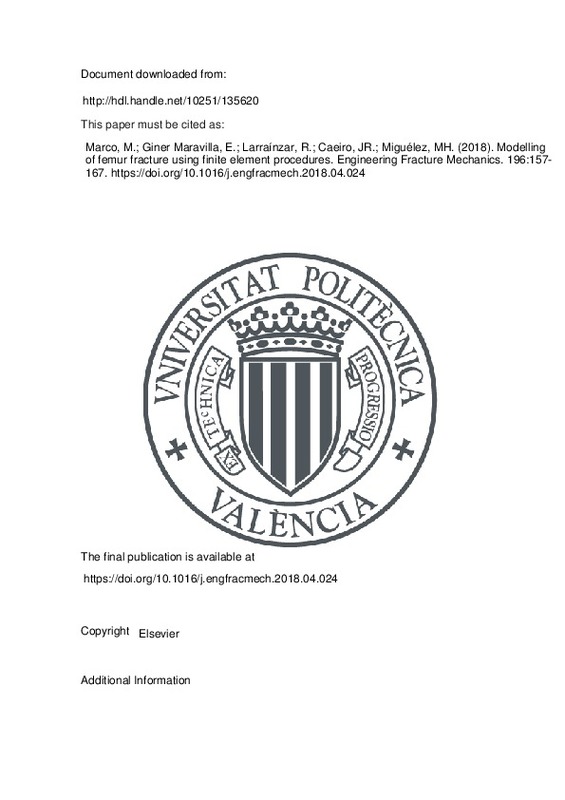JavaScript is disabled for your browser. Some features of this site may not work without it.
Buscar en RiuNet
Listar
Mi cuenta
Estadísticas
Ayuda RiuNet
Admin. UPV
Modelling of femur fracture using finite element procedures
Mostrar el registro sencillo del ítem
Ficheros en el ítem
| dc.contributor.author | Marco, Miguel
|
es_ES |
| dc.contributor.author | Giner Maravilla, Eugenio
|
es_ES |
| dc.contributor.author | Larraínzar, Ricardo
|
es_ES |
| dc.contributor.author | Caeiro, José Ramón
|
es_ES |
| dc.contributor.author | Miguélez, María Henar
|
es_ES |
| dc.date.accessioned | 2020-01-26T21:01:56Z | |
| dc.date.available | 2020-01-26T21:01:56Z | |
| dc.date.issued | 2018 | es_ES |
| dc.identifier.issn | 0013-7944 | es_ES |
| dc.identifier.uri | http://hdl.handle.net/10251/135620 | |
| dc.description.abstract | [EN] During the last decades human femur fracture has been mainly analysed using an experimental approach focused on cadaveric or synthetic bones. Nowadays, advances in computational technologies allow using numerical methods, such as the finite element method for femur fracture analysis. However, fracture morphology has been scarcely studied using numerical methods despite the interest of this study due to the different clinical treatment required for each fracture type. In this work, different fracture modelling techniques have been analysed with the objective of predicting a realistic fracture path, which in the literature is often limited to the initial steps of fracture. The main goal of this article is to compare different numerical approaches and to provide a robust methodology for femur fracture simulation. Experimental work was carried out on a synthetic femur in order to validate the numerical models. Through this validation we verified that some numerical methods present convergence problems, and they are not useful to model long crack paths. The best results are obtained by simulating the crack growth by a local material property degradation applied through successive analyses. This technique has been applied to a real human femur, obtaining accurate results in fracture morphology prediction. | es_ES |
| dc.description.sponsorship | The authors are indebted to the Universidad Complutense de Madrid and Hospital Universitario Infanta Leonor for the support in the scanning and the testing human femur. The authors gratefully acknowledge the funding support received from the Spanish Ministry of Economy and Competitiveness and the FEDER operation program for funding the projects DPI2017-89197-C2-2-R, RTC-2015-3887-8 and the Generalitat Valenciana through the project Prometeo 2016/007. | es_ES |
| dc.language | Inglés | es_ES |
| dc.publisher | Elsevier | es_ES |
| dc.relation.ispartof | Engineering Fracture Mechanics | es_ES |
| dc.rights | Reserva de todos los derechos | es_ES |
| dc.subject | Femur fracture | es_ES |
| dc.subject | Finite element analysis | es_ES |
| dc.subject | Numerical modelling techniques | es_ES |
| dc.subject | Numerical prediction of fracture | es_ES |
| dc.subject.classification | INGENIERIA MECANICA | es_ES |
| dc.title | Modelling of femur fracture using finite element procedures | es_ES |
| dc.type | Artículo | es_ES |
| dc.identifier.doi | 10.1016/j.engfracmech.2018.04.024 | es_ES |
| dc.relation.projectID | info:eu-repo/grantAgreement/MINECO//DPI2013-46641-R/ES/DESARROLLO DE MODELOS MICROESTRUCTURALES DE TEJIDO OSEO Y APLICACION A PROCEDIMIENTOS DE EVALUACION DEL RIESGO DE FRACTURA/ | es_ES |
| dc.relation.projectID | info:eu-repo/grantAgreement/GVA//PROMETEO%2F2016%2F007/ES/Modelado numérico avanzado en ingeniería mecánica/ | es_ES |
| dc.relation.projectID | info:eu-repo/grantAgreement/MINECO//RTC-2015-3887-8Q4618002BC.VALENCIANA/ES/DISEÑO AVANZADO Y FABRICACIÓN DE PROTECCIONES PERSONALES INTEGRALES DE USO MILITAR Y PARA FUERZAS Y CUERPOS DE SEGURIDAD DEL ESTADO (PROTEC_DAF)/ | es_ES |
| dc.relation.projectID | info:eu-repo/grantAgreement/AEI/Plan Estatal de Investigación Científica y Técnica y de Innovación 2013-2016/DPI2017-89197-C2-2-R/ES/TALADRADO DE COMPONENTES HIBRIDOS CFRPS%2FTI Y TOLERANCIA AL DAÑO DEBIDO A MECANIZADO DURANTE EL COMPORTAMIENTO EN SERVICIO DE UNIONES ESTRUCTURALES AERONAUTICAS/ | es_ES |
| dc.rights.accessRights | Abierto | es_ES |
| dc.contributor.affiliation | Universitat Politècnica de València. Departamento de Ingeniería Mecánica y de Materiales - Departament d'Enginyeria Mecànica i de Materials | es_ES |
| dc.description.bibliographicCitation | Marco, M.; Giner Maravilla, E.; Larraínzar, R.; Caeiro, JR.; Miguélez, MH. (2018). Modelling of femur fracture using finite element procedures. Engineering Fracture Mechanics. 196:157-167. https://doi.org/10.1016/j.engfracmech.2018.04.024 | es_ES |
| dc.description.accrualMethod | S | es_ES |
| dc.relation.publisherversion | https://doi.org/10.1016/j.engfracmech.2018.04.024 | es_ES |
| dc.description.upvformatpinicio | 157 | es_ES |
| dc.description.upvformatpfin | 167 | es_ES |
| dc.type.version | info:eu-repo/semantics/publishedVersion | es_ES |
| dc.description.volume | 196 | es_ES |
| dc.relation.pasarela | S\360508 | es_ES |
| dc.contributor.funder | Generalitat Valenciana | es_ES |
| dc.contributor.funder | Agencia Estatal de Investigación | es_ES |
| dc.contributor.funder | Ministerio de Economía, Industria y Competitividad | es_ES |







![[Cerrado]](/themes/UPV/images/candado.png)

